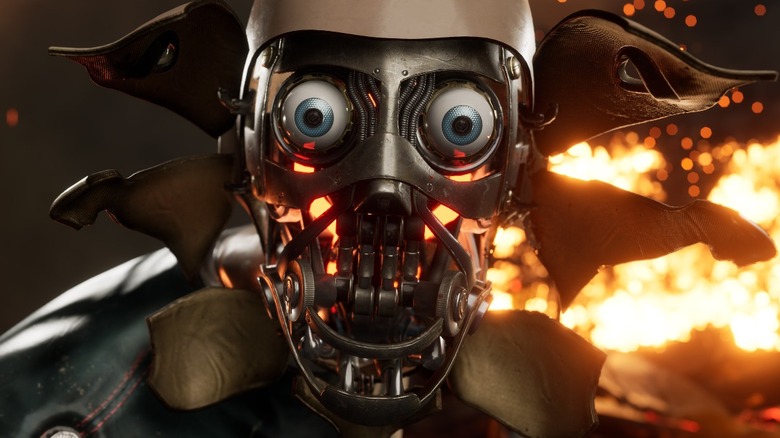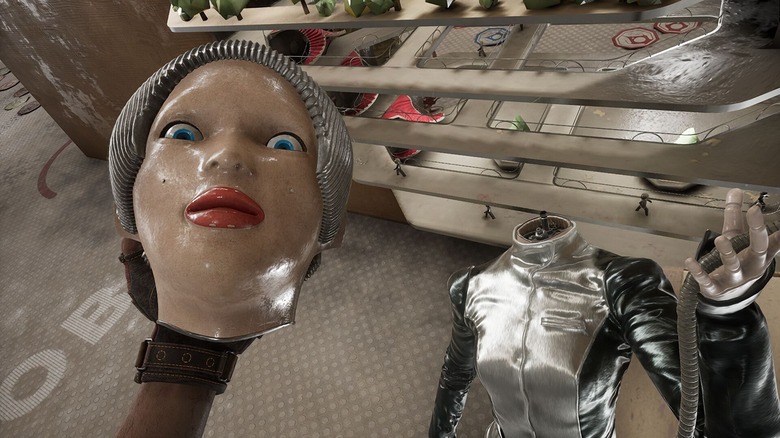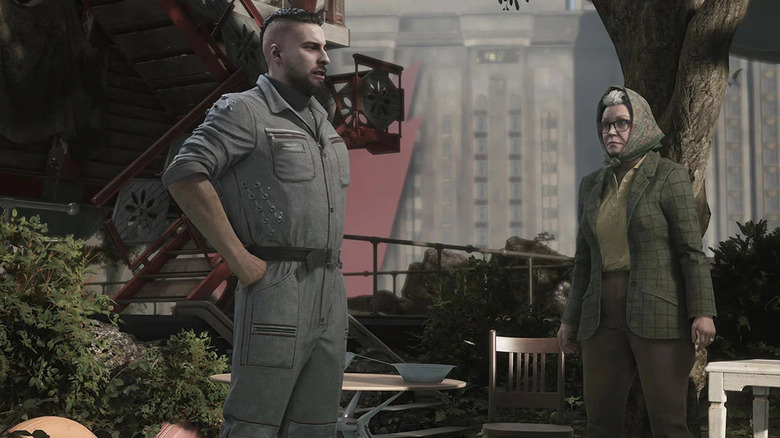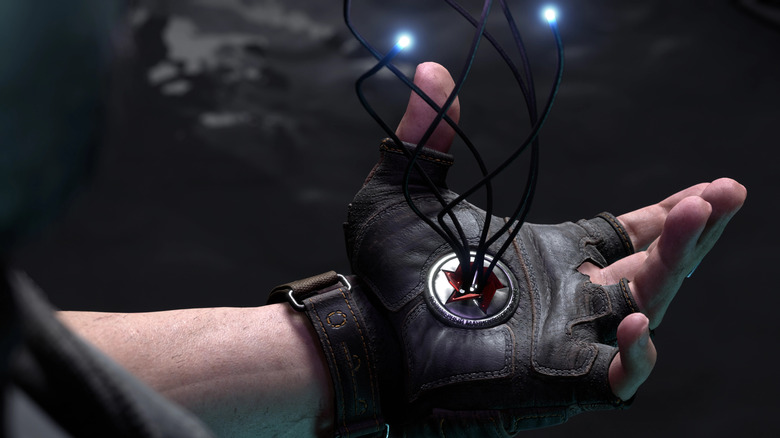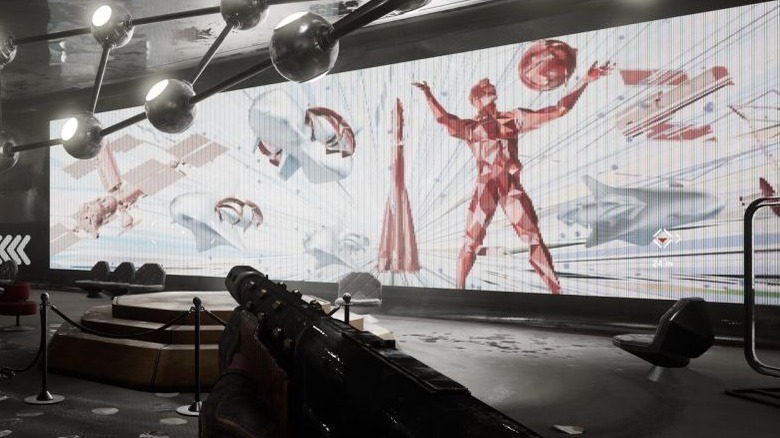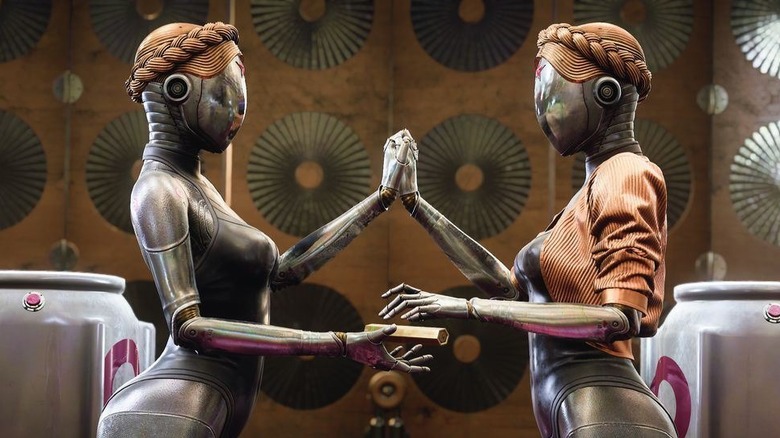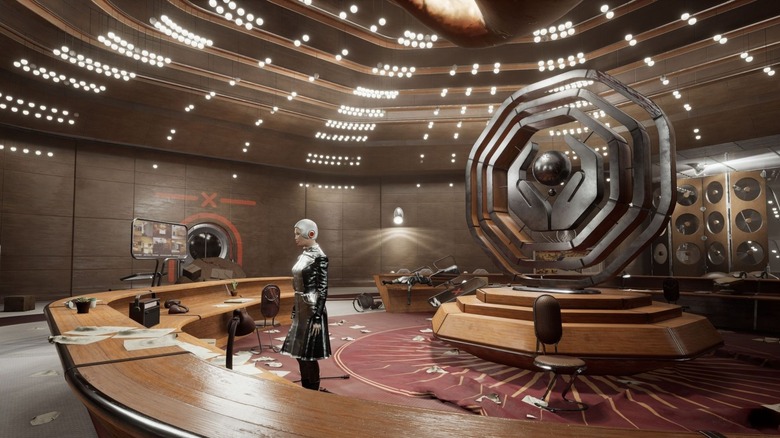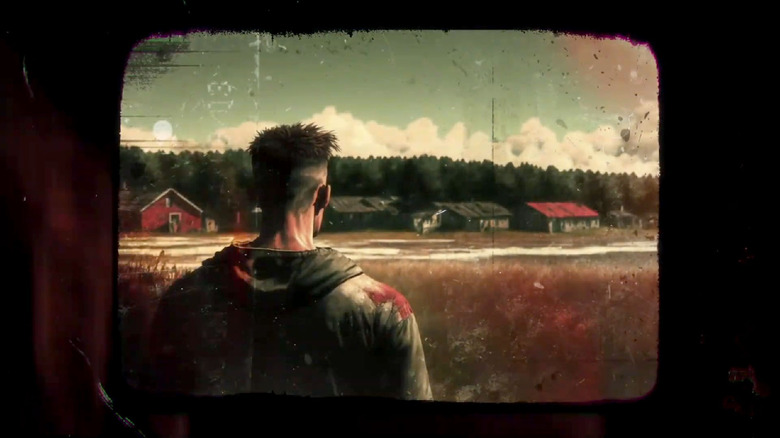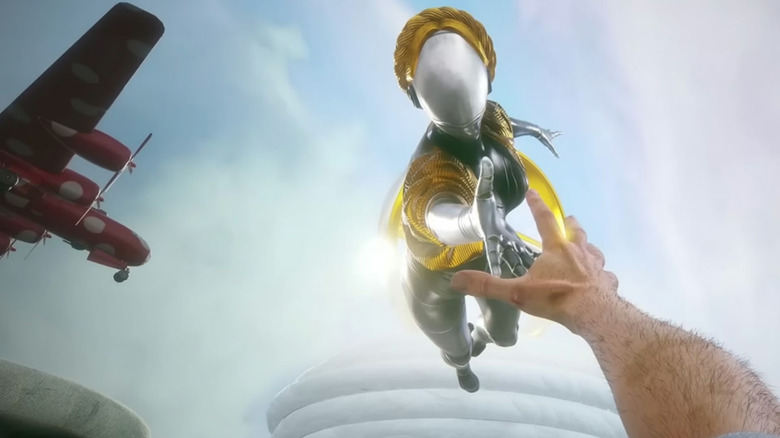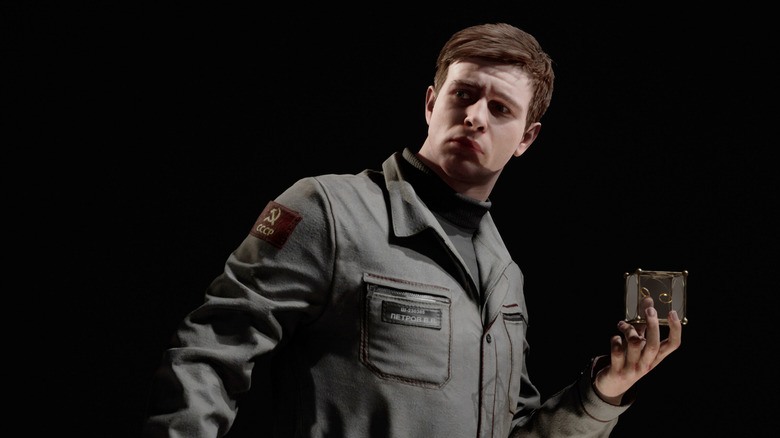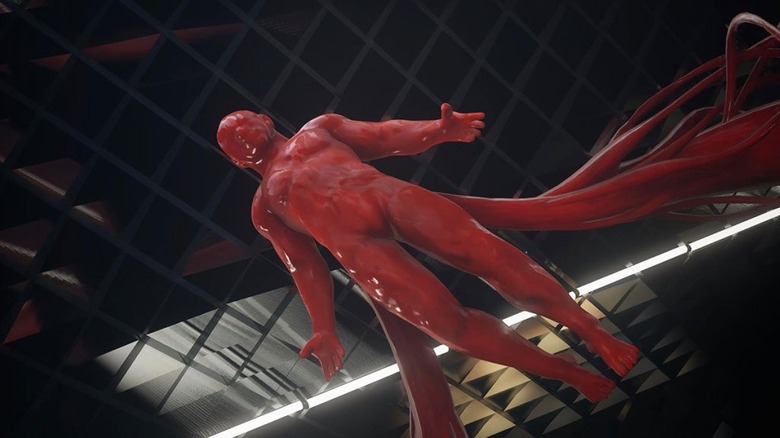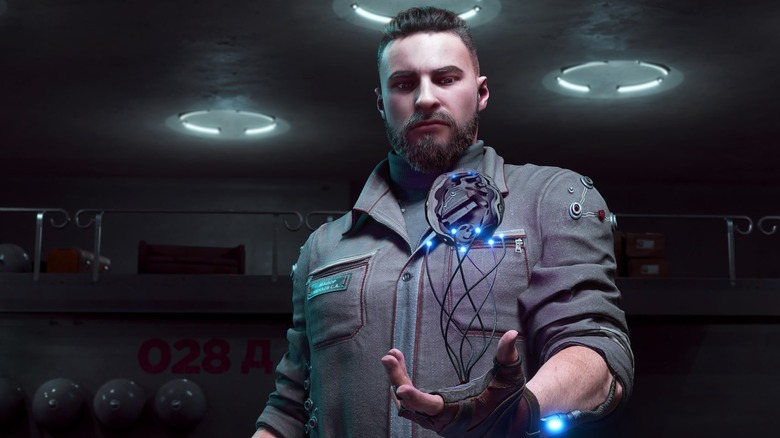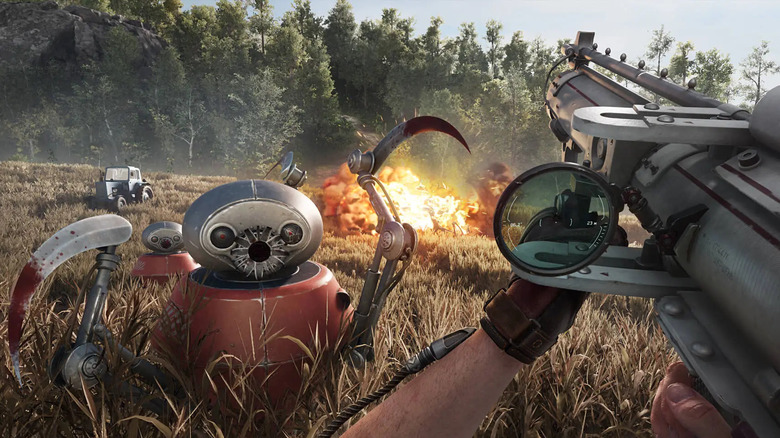Atomic Heart Ending Explained
Contains spoilers for "Atomic Heart"
"Atomic Heart," Mundfish's first-person shooter, draws strong inspiration from titles like "BioShock." Leading up to its release it garnered a lot of hype and excitement thanks to its amazing visuals, creepy atmosphere, and mysterious presentation. The mystique and the incredible world only expand throughout the game's roughly 16-hour runtime, which can make it hard for players to keep track of every detail and story beat thrown at them.
During the "Atomic Heart" introduction gamers learn about the setting's alternative history where the Soviet Union won World War II and rode that momentum to become a leading world power. This happened, in part, due to the Soviet Union discovering a new technology known as polymer. Acting at the center of the Soviet Union's technological advancements, polymer comes in various forms, but the campaign never concretely explains its functions. The game does reveal, however, that polymer can act as an energy source, transfer information, and, in the case of Red polymer, even absorb the consciousness of living beings.
The power of polymer also allowed the Soviet Union to develop a project known as Kollective 2.0, which promises to connect every person and robot to a single server, bringing true equality to all. Players can easily miss the nature of Kollective 2.0 early in the game. Now that we've covered the main concepts, let's examine the complicated ending of "Atomic Heart."
The Atomic Heart project
The final act of "Atomic Heart" starts with the revelation of what the Atomic Heart project actually is. While the player fights through hordes of robotic servants turned violent at the research base of Facility 3826, P3 hears references to the project for a while before learning about its details through recordings of Soviet Union officials speaking about it. The project is centered around the same robots that players have been killing, and having them be sold to the United States as worker robots to speed up manufacturing and keep its citizens from having to perform menial labor.
Once enough robots were in place in the Soviet Union's most despised enemy, the secret combat capabilities instilled in their programming would be activated, allowing the Soviet Union to spring a surprise attack on the United States from every direction and already within its borders. However, trade sanctions imposed on the Soviet Union restricted how many robots could be imported each month slowing down the process, much to the Soviet Union's chagrin.
The events of "Atomic Heart" that P3 finds himself in serve as a precursor to the violence that the Soviet Union expected to unleash upon the United States, as the combat modes of all the robots were activated by a hacker and former researcher on the project known as Petrov. They also threatened to reveal the plan to the world, which is why P3 was sent to shut it down.
The gold rings
After learning about the Atomic Heart Project, P3 is captured by the very hacker behind the robot revolution, Petrov, and his ally Dr. Filatova. Petrov and Filatova exposit additional information to P3, revealing that they knew about the Atomic Heart Project. The scene also reveals that Petrov started the robot revolution without Filatova knowing about it, although his reason for doing so is left a mystery. P3 eventually escapes them because of their argument, allowing him to continue hunting down Petrov.
When P3 reaches Petrov, however, he seems to be experiencing mental instability. The player has to wait a while to learn what exactly drove him to this state, but in his ramblings, Petrov gives him a small cube holding two gold rings. Then, Petrov is beheaded by a robotic arm of his own design. Up until that point, the rings have been referenced by multiple characters that have wanted P3 to hand them over to them. The player is never directly told what they do, but there are numerous clues that can be pieced together to deduct why they are so important.
The gold rings are what are known as beta connectors for the launch of Kollective 2.0. This means that the two individuals connected to them would be able to connect to Kollective 2.0 and use it like anyone else, but without other users being able to give them commands or even know that they are connected at all.
The glove influences P3
After getting his hands on the beta connectors, P3's AI glove, known as Charles, begins asking him about who he plans to give them to. There are primarily two options available to P3. The first is P3's boss, dear friend, and the leader of the Kollective 2.0 project, Sechenev. The other option is a strange old woman that P3 runs into throughout his adventure and who consistently helps him, known as Granny Zina. It is hinted that Sechenev aims to use the beta connectors with his two prized robot bodyguards that resemble ballerinas, but it is unclear what Granny Zina plans to do with them.
However, P3 ends up not giving them over to anybody. Instead, Charles persuades him to throw them into the ocean, assumedly destroying them and preventing anyone from having that much power within Kollective 2.0. This moment is an interesting turn because it shows P3 breaking from obeying commands without question but also that Charles carries some influence over him. Up until that point P3 had largely ignored and belittled Charles' advice and opinions, but destroying the beta connectors illustrates that the two grow closer throughout the game's adventures.
The truth of Kollective 2.0
After destroying the beta connectors P3 continues on his journey to a lighthouse housing an elevator to a secret section of Facility 3826. The sequence is a massive nod to "BioShock," complete with an elevator going underwater that overlooks a city and P3 noting that it all looks like a "rapture." Accompanying him on the elevator is Filatova, who joins P3 to help him find a way to end the robot revolution. The elevator ends up leading to a horrifying scene of people trapped in small cubicles where they are used as test subjects.
Filatova explains to P3 and the player that the people there are being used to test Kollective 2.0. She then reveals the true nature of Kollective 2.0 as a massive mind-controlling enterprise. The human test subjects are shown being covered in their own blood and wearing pieces of equipment that resemble modern VR headsets. These allowed their minds to be taken over by Kollective 2.0 while their consciousnesses were thrown into strange isolated dream worlds known as Limbo. Filatova reveals to P3 that this is why she and Petrov were attempting to stop the launch of Kollective 2.0, with Petrov experiencing mental instability due to his involvement in developing a system that could enslave the entire world.
P3's corruption
It is at this point that players are able to start piecing together some strange happenings with P3 that pop up throughout the game. During various scenes, P3 is thrown into strange dream sequences before coming out of them to find time has passed in the game world. With the new knowledge of Kollective 2.0 and Limbo, it is revealed that P3 was being controlled by Kollective 2.0 throughout the game, allowing him to be used by Sechenov toward various ends.
One example of this happening is when P3 is present when members of the Soviet Union government tell Sechenov that he is being detained and removed from the Kollective 2.0 project because he broke the law. When this occurs P3 falls unconscious and enters Limbo. When he comes to, the government members have all died through very brutal means. Sechenov then tells him that while he was unconscious the room was attacked by a horde of robots that his ballerina robots were barely able to fend off.
With the knowledge of the truth of Kollective 2.0, however, the player knows that P3 was actually taken over by Sechenov who controlled his body to kill members of the Soviet Union government that P3 was sworn to be working for. This is a massive betrayal for P3 as he wholly trusted in and respected Sechenov like nobody else.
P3's past revealed
Shortly after discovering the truth of Kollective 2.0, Filatova also fills P3 in on how he is ingrained in the development of Kollective 2.0 as well as wrapped up more closely with Sechenov than he originally knew. Throughout "Atomic Heart" P3 references how he is indebted to Sechenov because he saved P3's life after he was mortally wounded in World War II. This not only saved his life but also smoothly transitioned him into working for Sechenov as a special operations agent for the Soviet Union.
However, Filatova reveals to P3 that when his life was saved Sechenov implanted an experimental piece of technology known as a Brain Polymer extension that was used to erase his PTSD. However, it not only alleviated his PTSD symptoms, but it also erased the memories that led to it, like the memories of his wife who was killed during the war. The Brain Polymer extension also allowed Sechenov to transmit Kollective 2.0 into P3 to use him as one of its earliest test subjects on top of stealing his past from him completely.
It also comes out that the consciousness and abilities of P3's wife were stolen by Sechenov shortly after she died using the terrifying Red Polymer to copy it. For reasons that aren't explained, Sechenov then put that consciousness into his prized robot ballerinas, allowing them to become proficient dancers and combatants while erasing his wife's entire memory and personality.
The bad ending
After learning of his past P3 returns to Granny Zina, who he finds out is his mother-in-law from his marriage. This implies that Granny Zina is at Facility 3826 because she knows that her daughter's mind was stolen and placed in the two robot ballerinas, but her goal there is never explored. When P3 meets with her, she gives him the choice of how to move forward, which determines the ending shown at the close of the game.
If the player chooses to leave Facility 3826 behind to try and live his life after rejecting Sechenov's designs and his role within them they are given the bad ending. This sees him destroying his prototype glove and walking away. A cutscene plays saying that P3 was last seen walking through farm fields moving away from the research facility. The cutscene also references a strange chunk of polymer that was seen at the facility, but that goes unexplained unless the player chooses the option to get the canonical good ending.
The good ending
If the player instead chooses to have P3 accept Granny Zina's help to go and face Sechenov once and for all they are given the good ending, which is widely considered canonical. P3 is then taken to an armory of Granny Zina's where he is able to grab equipment and gear to prepare for the final showdown. Before reaching Sechenov P3 has to face off against the ballerina twins in a challenging boss fight that ends with both of the robots being completely destroyed, freeing the consciousness of P3's wife from its imprisonment.
P3 then approaches Sechenov, after which Charles subdues him with electrocution. Charles then disables P3 as well, after which he transports his own consciousness into Red Polymer, which gives him a human form. It is then revealed that Charles is actually the consciousness of Sechenov's original partner when developing polymer named Zakharov. How Sechenov got a hold of Zakharov's consciousness is not explained, but once he is inside the Red Polymer he absorbs Sechenov and explains to P3 that he was manipulating him the entire time.
Zakharov then explains that he believes polymer and its creations are the next dominant species of the world and that with Kollective 2.0 he will be able to enslave humanity to shape his vision for the future. P3 is then sent to Limbo where he is joined by one of the robot ballerinas and the game ends.
Petrov's ending
Petrov is a pivotal character in "Atomic Heart" who carries a lot of influence throughout the game's story while contributing to its central theme as well. He was a pivotal developer of Kollective 2.0 and vowed to try and stop its release once he discovered what it was really being used for. This led to him hacking into the systems of the robots at Facility 3826 in an attempt to slow down production and possibly draw attention to what the Soviet Union was actually doing. He also proves himself to be extremely capable when he is being chased by P3, as he fakes his own decapitation to escape his pursuit early on in the game.
However, Petrov ties into the main theme of "Atomic Heart" by becoming a tragic figure that is driven to mental instability and eventually suicide by his own creation. The sheer weight of facing down a future where humanity was enslaved and eradicated by a superior creation, as well as his own role in facilitating such a future, is enough to break Petrov. While starting as an antagonistic force that P3 pursues, Petrov is revealed to be another victim similar to P3 that was manipulated, used, and tossed aside by the Soviet Union in the name of advancement.
Charles' ending
Charles is also a particularly interesting character at the center of the story of "Atomic Heart." When first introduced, Charles is portrayed as a stereotypical AI that gets on P3's nerves with his constant advice and habit of stating the obvious. To this end, P3 responds to most of his statements throughout the majority of the game with mockery, derision, and irritation. This changes, however, as Charles gets closer to P3 and begins manipulating him to facilitate his control of Kollective 2.0.
With this comes the reveal of Charles' identity as Zakharov, a scientist that worked alongside Sechenov to discover polymer and develop new technologies with it. Once Zakharov is put into the glove and becomes Charles, however, he becomes obsessed with polymer. He begins viewing it as more worthwhile than human life and designs a plan to have it become the dominating life on all of the Earth, no matter the cost. This ties him into the game's core theme of technology going too far perfectly and sees him being a driving component of the exploration of that theme.
P3's ending
P3 is an interesting character because of how he both embodies and subverts the expectations of a first-person shooter's protagonist. He is a hardened and capable veteran that manages to take down an entire army of robots all on his own while maintaining an irreverent attitude toward the violence and danger he finds himself in. He also starts "Atomic Heart" as a devoted believer in the Soviet Union. Even after almost giving his life to his country during World War II he continues to serve in its special forces, partially out of a deep respect for Sechenov after he saved his life.
However, P3 also subverts what many players expect from a stoic protagonist like P3 based on how they are usually developed in similar games. Rather than being able to solve everything with some grit and a gun, P3 is ultimately a tool manipulated and used by his superiors toward the nefarious ends that he hopes to prevent. He is abused to test technology that is too complicated for him to fully understand and ends up giving his life to advance that very technology despite disparaging it throughout the game in the form of his comments toward Charles.
Core theme: The danger of progress
"Atomic Heart" revolves around the dangers presented when technology and progress go too far, a theme explored throughout its gameplay and story. Progress rests at the heart of the title's alternate reality where the Soviet Union rocketed itself into the future far beyond the actual technology of the world in the 1950s. At first, the player sees how great of an impact this has had as they are guided through a tour of a beautiful and idyllic village in the opening moments.
By the time the player has fought their way through countless locales filled with human corpses and taken on multiple dangerous bosses to reach the end of the game, this portrayal largely changes. The terror at Facility 3826 only came about because of the advances that the Soviet Union made. While these advances generally brought a lot of good to the nation, they also posed a terrible risk when the situation deteriorated.
The game also highlights how progress and new technologies open the door to greater threats and machinations by corrupt individuals in power. The potency of polymer and the robot army it controls presents entirely new possibilities for those in power to abuse and use to further expand their reach and influence over the world. It highlights the double-edged sword of new technologies that can always be turned to evil or violent purposes despite their positive impacts.

